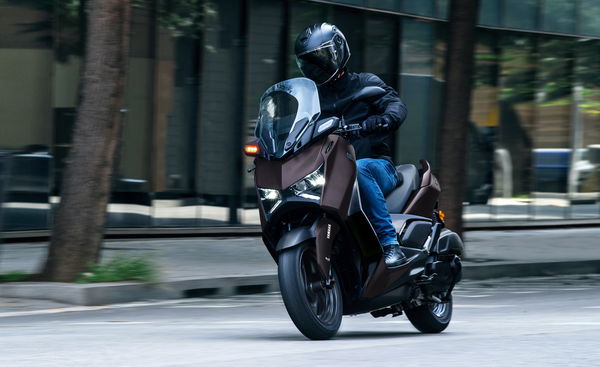10 Greatest Grand Prix races - ever
We've asked the most knowledgeable race pundits in the world and picked out their top Grand Prix races
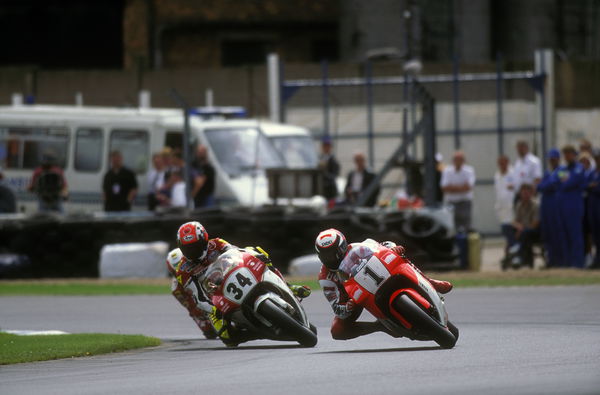
Bazza - in action at the 1979 British Grand Prix |
1. 1987 BRANDS HATCH, TRANSATLANTIC RACE,
KEVIN SCHWANTZ AND
WAYNE RAINEY
The Transatlantic Races were an incredible phenomenon, for two decades (running through the '70s and '80s) this UK vs USA team event introduced to British and European fans incredible talents that may not otherwise have been seen outside of the States, including the likes of Cal Rayborn, Kenny Roberts and Freddie Spencer. By the late 1980s though, the races were on their last legs.
Their last hurrah came in 1987 when virtual unknowns Kevin Schwantz and Wayne Rainey arrived, tooled up on a Yoshimura GSX-R750 and an American Honda VFR750. Not only did the pair totally shred the competition and the Brands Indy lap record, they did it side-by-side, in a fairing bashing, kickin', punchin' display of furious rivalry that we'd never seen before, nor since. Whether you were stood at Paddock or Clearways, you thought the same thing: 'that's just not possible'. But clearly it was. Jaws hit the floor all around the Kent circuit.
The guys were inspired, for the first race at least, by an offer of £100,000 to a rider if he won all the six Transatlantic races. As Schwantz said later, "We agreed as a team, 'let's see who wins the first one, you guys just go scrap, and then before the second race we'll talk about it'. Well, Wayne wouldn't have nothing to do with it, because I won the first one!"
Kevin and Wayne would fight on like this for another seven years, but if you were there in 1987 you'd argue that no subsequent race was as tough, or as pure since then. A worthy winner.
2. 1983 ANDERSTORP, SWEDISH GRAND PRIX,
Kenny Roberts' career yielded at least two iconic moments. One was the battle with Barry Sheene at Silverstone in 1979, which he won. The other race may be more memorable. This time he lost.
Freddie Spencer was his rival, on the nimble three-cylinder Honda. They were neck and neck on points for the '83 championship, with two races left, and had been battling for the lead
throughout the Swedish GP. It came down to the last corner, and Roberts thought he had it covered. "My mistake was I underestimated just how big a risk he would be willing to take," he said later. He braked late, knowing he was on the limit. Yet Spencer came past on the inside. Roberts was right enough about the limit: Freddie didn't make the corner. But he took Roberts out onto the dirt. Spencer recovered first and made it through the last remaining corner to win the race. He went on to win the title by just two points.
3. 1988 PAUL RICARD, FRENCH GRAND PRIX
The old Paul Ricard - using the full Mistral straight - was close to heaven, especially when the weather was as azure-blue as in 1988. The 500cc race, bang in the middle of a golden age, had other aspects of divinity. Wayne Gardner, defending champion, trailed Eddie Lawson by 20 points. But Eddie had dislocated his shoulder a week before. Gardner's luck seemed to be turning. Problem was the others: Rainey and Schwantz. And Sarron - who had taken his fifth pole in a row. In the race the pace was so hot that Rainey was unable keep up. The first surprise came from injured Eddie (he'd rejected painkillers). Instead of a steady ride, he'd pushed past Rainey, and joined the leading trio. The sight of four 500s on full noise running into the fast corner at the end of the long straight was unforgettable. With one lap to go, Gardner had the lead. But at the end of the straight, a loosened crankshaft bolt broke into the water pump. He clattered to a stop. Amazingly, he managed to get it going again, on three cylinders, and finish fourth. Up front, Sarron tactfully rode shotgun to Lawson, keeping Schwantz third, less than half a second off the leader. It was one of Eddie's bravest and best races.
4. 1991 HOCKENHEIM, GERMAN GRAND PRIX,
RAINEY AND SCHWANTZ
Hockenheimring in 1991 was another Rainey-Schwantz classic. Hockenheim was dauntingly fast and this year it was destroying tyres. Schwantz and Rainey shredded several in practice; Dunlop flew special ones in. In the race, series leader Doohan was trying to break away when (irony of ironies) his rear Michelin threw a chunk. It came down to the two old rivals. On the last lap Schwantz regained the lead at the distant Ostkurve, but Rainey drafted past again on the final straight. Then came Schwantz's epic outbraking move, into the stadium section. The Suzuki was sideways at 180mph - but he was alongside, and had the inside line. Rainey fought back but lost by only 0.016 seconds.To Schwantz, it was avoidance. "He took me by surprise braking so early, I had to swerve like that to avoid hitting him." To Rainey, it was a typical bonehead move. "It's the way Schwantz used to race. I had to give him room. If it'd been the other way round, he'd have taken me out."
Brands Hatch - Schwantz versus Rainey |
5. 1999 DAYTONA 200,
MIGUEL DUHAMEL AND MAT MLADIN
To understand the magnitude of Miguel Duhamel's win in the 1999 Daytona 200 you have to go back to June 1998 when Duhamel suffered a compound fracture of his right leg when he crashed into an unprotected wall at New Hampshire Raceway. His femur came through his leathers.
When he arrived in Florida in '99, on crutches, he told his crew he was "just there to do laps and and get some points". The first surprise came on Saturday when he got off his crutches long enough to beat Kurtis Roberts by 0.066 secs in the Supersport. In Sunday's Superbike race Duhamel did it again. Daytona is often decided in the run from the last chicane, along the banking to the chequered flag. Duhamel led Mladin. "I weaved a few times and he got close, but not close enough. (The margin of victory was 0.014 secs.) I didn't even want to celebrate after that. If I could have rode my bike straight to the Hampton Inn and gone straight to sleep, I would've done it."
6. 2002 IMOLA
WORLD SUPERBIKES,
EDWARDS AND BAYLISS
The 2002 championship went down to the last round at Imola. After Troy Bayliss had led early season Colin Edwards mounted the all-time greatest fight backs imaginable winning almost all the races in the second half of the year.
At the final round, at one of the most challenging and beautifully appointed racetracks ever, Edwards' determination and pace had teed up a denouement laden with drama and uncertainty. With so much to play for it was obvious that there would be an element of cat and mouse. Not really, more like two wildcats clawing and spitting their way round one of the more dangerous and high velocity tarmac roller coasters. It was an awesome spectacle from start to heart-stopping finish, and the championship went right down to the final corner, with Edwards claiming a championship win in a champion's fashion. It was bloody spectacular.
7. 1992 HUNGA'RING, HUNGARIAN GP
EDDIE LAWSON
'Steady Eddie' recorded the last of his 31 GP wins in the final term of his 10-year career. His last two seasons were on the less than competitive Cagiva V591/592 and despite his abilities he wasn't expected to be winning. Perhaps this led to a freedom to gamble on the wet race at the Hungarian GP in 1992. Every rider save for Eddie started on full wets. Eddie gambling on the rain stopping and the track drying and chose slicks. Initially he dropped back alarmingly - his gamble looked lost when he'd slipped to over a minute behind the leaders. But at half distance, the rain stopped and the track dried. Eddie got into overdrive. A good 10-seconds a lap advantage saw him storm him through the pack. When he got to Doug Chandler and Randy Mamola at the front, now on fried wets, they had no defence. Cagiva boss Claudio Castiglioni promptly rewarded Eddie with a Ferrari Testarossa. Remembered for ever by Eddie fans as a great performance, Eddie himself was reticent, "The win meant a lot to me to be the first to win on a Cagiva, but I'm not as proud of that win as I am of others. But hey, winning a GP, no matter how you win, is nice."
8. 2006 PORTUGUESE GP,
ELIAS AND ROSSI
Asked back in his 125 days why he had such an aggressive riding style, Toni Elias told us with a toothy laugh, "I like the other people to know I am there." He has a peculiar style, riding the front wheel with the back really loose. Sideways and fast. But it wasn't until the Portuguese GP of 2006 that he'd finally got the tyres he needed to make the most of it on a MotoGP bike. The race was defined early on when championship leader Hayden was skittled by team-mate Pedrosa. It was a golden chance for Rossi to catch up. But he wasn't alone. Not only did he have former title rival Kenny Roberts for company, he also had Elias. And Elias was letting him know he was there. The battle went to the end, Elias finding ever stranger places to pass Rossi. In the end, his screaming exit from the final corner was too much even for Rossi to cope with. Elias won the race by two thousandths of a second. The five points he cost Rossi were exactly the amount by which he lost the title to Hayden.
9. 1992 SENIOR TT, ISLE OF MAN
STEVE HISLOP AND CARL FOGARTY
Steve Hislop and Carl Fogarty had ridden exotic factory Hondas in the 1991 TT but for the '92 Senior they had much less glamorous mounts. Hizzy rode the Norton rotary he had previously thought a "bit of a joke", while Fogarty rode an ageing Yamaha OW01. The scrap that ensued is now legendary: in what was the fastest-ever TT race at that point, the pair were never separated by more than six seconds, and Foggy set an outright lap record (123.61mph) that would stand for seven years. Hislop struggled to control the vicious Norton throughout the 226-mile race. "I was hitting bumps and getting lifted up out of my seat," he said afterwards. Fogarty, in response, rode his Yamaha to near destruction. "None of the clocks were working, the front fork seal had gone, the rear brake bent, the rear shock broke," he admitted. "To make matters worse, the exhaust blew coming over the Mountain as I made that final push." His final push resulted in that stunning lap record but it wasn't enough to beat Hislop who took victory by just 4.4 secs. It was the first time a British bike had won the Senior TT since Mike Hailwood won on a Norton in 1961.
10. 2007 SPANISH GP,
CASEY STONER AND VALENTINO ROSSI
Tooth-and-nail is alive and well in the 800cc era. The proof came at Catalunya, where almost uncountable overtakes between Rossi and Stoner ended up with the Australian's Ducati ahead by a nose. At the end, his 12kph speed advantage proved decisive. What made it a great race is how hard Rossi tried to overcome it. Not many a rider would have resisted that pressure, no matter how fast his motorcycle. Afterwards, Rossi acknowledged Stoner's feat. "He is riding like a god," he said.
It was the sixth race of the new 800cc era, an age that had started with several surprises. One was that Honda was off the pace. Another was Casey Stoner and his Ducati. The bike was blindingly fast in a straight line, and he was riding consistently fast round the other parts. Last year's frequent crasher has turned into a mature would-be champion.
11. 2000 OULTON PARK,
BRITISH SUPERBIKES
NEIL HODGSON'S
LAST-TO-FIRST WIN
Niall Mackenzie was Neil Hodgson's team mate that year on the INS GSE Ducatis. "He had been much stronger than me all season so when his bike stopped before the warm up lap and he had to start from the back of the grid I was grateful of the rare opportunity to finish ahead of him.
I shouldn't have tempted fate as he was super angry and super fast that day, not only beating me but everyone else on the grid as well. He was half way through the pack on the first lap and comfortably picked the rest off before getting to the chequered flag first. He won the championship that year from Chris Walker but had he not found that special something that day Suzuki and Walker would have taken the title."
12. 1991 JAPANESE GP
WAYNE GARDNER'S SWANSONG
Wayne Gardner is another with so many great races it's hard to pick one, ranging from the 1989 Australian GP to his 1992 swansong defeat of Wayne Rainey at Donington Park.
For sheer grit, nothing beats the Japanese GP of 1992. The race was streaming wet. Gardner was one of many who fell victim to the conditions early on, slipping off into the mud at the Esses. The Wild One was never a quitter. He ran back to his filthy bike, ripped off the remains of the screen, and took off after the rest of them, right at the back. Passing four riders in two laps at one point, he was charging to the front. With four laps to go, he was catching fifth-placed Mamola at three seconds a lap. Trying harder still, he slipped off again at the exit of the Esses, right where the guard rail cuts back across the corner exit. He slid under the laughable foam rubber protector and slammed into it, breaking his leg so badly his season was ruined. He later announced his retirement, and then claimed that final win in Great Britain.
True grit.
13. 1988 BRNO, CZECH 250CC GRAND PRIX
JUAN GARRIGA'S AND SITO PONS
Juan Garriga and Sito Pons were both from Catalunya, but poles apart. Pons, sleek and posh, had given up a career as an architect to go racing. Garriga, thin and edgy, had battled his way up from the poor side of town. In 1998 the pair battled for the 250 championship. At Brno, the penultimate round, Garriga raced from 10th to make a ferocious pass on Pons for the win. Garriga's win brought him within six points of Pons' championship lead. Then in Brazil he was taken out on the second lap. Garriga came back from 23rd to fifth, but it wasn't enough. The defeat marked the end of Garriga's prime. After racing he drifted into trading guns and drugs - which led to a stretch in jail.
14. 2003 DUTCH MOTOCROSS GP,
MIKAEL PICHON AND STEFAN EVERTS
Mikael Pichon came into 2003 as the reigning 250cc world champion. He rode for the best team, on the best bike - a very special RM250. Rival Stefan Everts was hardly the underdog but he'd recently lost two valuable years to injury. He was riding a new-wave 450cc four-stroke - a Yamaha YZF that in 2003 joined the 250cc two-strokes in the merged 'MXGP' class.
Pichon had won the season opener. At Valkenswaard, the Dutch round, it was Everts who took the early lead. But Pichon came back. Pichon was easily faster, but Everts, the fighter, blocked Pichon's passes. After a lap and a half of capers Pichon's patience wore thin and his passing attempts became tougher. Everts' tactics too became dangerous and Pichon had to be at his best to finally surge past. After having been blocked and ridden off-track too many times his footpeg met with the Yamaha's front wheel spokes. Everts was forced to pit for a new wheel. It was one of the most brutal motorcross races ever seen, but proved to be Pichon's last super-victory. Everts came back stronger and would take the title. Pichon meanwhile, always the fractious brittle type, slowly imploded in a turmoil of self-doubt. And for the two-stroke too, it marked the end of the road.
15. 2006 CROFT, BRITISH SUPERBIKES
LEON HASLAM'S IMPOSSIBLE RAIN RIDE
Normally a special race is about one rider and one result. This one was different as Leon Haslam and Karl Harris gave us one of the most fascinating BSB races to date. Initially it appeared that Karl Harris was on for his maiden Superbike win with the HRC HM Plant Honda Team. The torrential rain gave one of the most naturally talented riders on the grid the perfect opportunity to push aside the regular winners and put his Michelin shod Honda on the top step of the podium. Up until 3/4 race distance it looked like his job was done, but Leon Haslam was on fire and doing things in the wet that normal people simply cannot do as he used his traction control to best effect and took huge chunks out of Karl's lead. Karl was unable to do anything about it and when Leon got in front. Emotions were well and truly split between Haslam's elation and Harris's dismay. In the post-race interview's Karl simply didn't know what to say. An extraordinary race.
16. 2005 OSCHERSLEBEN 24 HOUR, WORLD ENDURANCE
The ultra-professional French Suzuki Castrol team were firm favourites for the 2005 championship when they arrived at the penultimate round, Oschersleben. However, within a few laps of the start the Suzuki Castrol crashed on oil. It rejoined the race but the first pitstop revealed that hot-shot rider Vincent Philippe had a broken wrist. They held first place but the next 23 hours would have to be shared by remaining riders Mattheu Lagrive and Keiichi Kitagawa. Rivals Yamaha Austria and Phase One piled on the pressure but Phase One's engine blew and the Austrians crashed out just after dawn, leaving deteriorating weather as the main challenge to the exhausted French riders. Suzuki Castrol crossed the line after nine more hours (an entire MotoGP season) of heavy rain to take the win and the World championship.
17. 2005 JEREZ, SPANISH GRAND PRIX
VALENTINO ROSSI AND SETE GIBERNAU
There's no doubt that for two years Sete Gibernau was the only rival to Valentino Rossi, and he beat him often enough to be called a worthy rival. When Rossi switched to Yamaha in 2004, he took Sete seriously enough that relations between the two soured. What turned it happened at Qatar in 2004 - the notorious incident where Rossi was moved to the back of the grid after his team had spun up a scooter tyre on the grid "to give Valentino a reference point" (or to try to work up some grip). Rossi blamed Sete for reporting him, called him "a spy", then proceeded to crash out of the race while Gibernau won. "He will never win another race," prophesied Rossi. He was correct, and the way he made sure of it was almost theatrical.
It was at Jerez in 2005. The two had scrapped to the end, Gibernau was leading on the run to the final hairpin. Until Rossi appeared, barely in control, and diving for the apex. The two touched, Gibernau ricocheted off into the gravel, where he recovered to take a highly disgruntled second. Rossi, unkindly, made fun of him afterwards, suggesting he was rather playing up his supposed shoulder injury. Gibernau's career slowly unwound, from that point onwards.
18. 2000 DONINGTON PARK,
WORLD SUPERBIKES
NEIL HODGSON AND CHRIS WALKER
We miss the wild wildcards in modern day WSB racing, but the best of the wildcard races ever held in this country was in 2000. In that year Noriyuki Haga (West Yamaha) was in contention for the championship win, making the R7 fairly sing. A legendarily tough competitor all round, Haga was to be feared by all - except nobody told the rejuvenated Neil Hodgson (INS Ducati) and perennially pugilistic Chris Walker (Crescent Suzuki) that they should show some respect. They simply battered Haga out of their way as they continued their on-track BSB battles into the World Superbike paddock, and Haga found himself suffering collateral damage to his bodywork and championship score.
Hodgson won the race, Walker went second, Chili third. It was stunning to watch and paved the way for Walker to go into WSB with Suzuki, which he then botched up with a daft decision to go to GPs.
19. 2000 BRANDS HATCH, WORLD SUPERSPORT
J…RG TEUCHERT & OTHERS
In a complicated and close season, the strong favourite Jšrg Teuchert (Alpha Technik Yamaha) was taken out at the penultimate race by his own team-mate Christian Kellner (Alpha Technik Yamaha) while in the lead. The arithmetic of who would be World Champion changed not just lap by lap but corner by corner, and even on the last lap, a pass or two by the riders behind eventual winner Karl Muggeridge would have seen virtually any one of the possible four champions go from winner to fourth.
As it turned out, James Whitham was instrumental in the final analysis. Had Whit overhauled Jšrg for second the German would not have been World Champion after all. With the top four riders - Muggeridge, Teuchert, Whitham and Kellner covered by only three quarters of a second, it was the most astonishingly tense finish, and surely a flag-to-flag multiple rider championship decider which will remain unmatched in the history of the supersport 600 series.
20. 1979 SILVERSTONE,
BRITISH GP, BARRY SHEENE AND KENNY ROBERTS
By 1979 Sheene was in his post-championship years, his two titles coming in 1976 and '77. But he was still in his prime and still, for this final year, with the works Suzuki squad. Sheene was at the height of his fame, making front cover tabloid material like no racer has since. And seeing as he was still Number Two in the world he had the ability to make Silverstone a sell-out and a must-see for millions of television viewers.
By modern standards the passes were very clean, almost incidental. The inter-rider taunts (a classic up-yours 'V' from Sheene famously misinterpreted as a wave by Murray Walker) seem almost Rossi-esque for their sense of pantomime. Perhaps what marks the race out for posterity is not that last lap lunge by Bazza, but instead the collective goose-bumps, hair-on-end sensation enjoyed simultaneously by millions of Britons. Exceeding maybe even those felt on the Island for Mike Hailwood's comeback win in 1978.
THESE ARE OUR TOP 20 RACES EVER AS SELECTED BY JON BENTMAN, MICHAEL SCOTT, GORDON RITCHIE, HENNY-RAY ABRAMS AND NIALL MACKENZIE. WHAT ARE YOUR TOP RACES?

10
10. 1979 SILVERSTONE, BRITISH GP, BARRY SHEENE AND KENNY ROBERTS
By 1979 Sheene was in his post-championship years, his two titles coming in 1976 and '77. But he was still in his prime and still, for this final year, with the works Suzuki squad. Sheene was at the height of his fame, making front cover tabloid material like no racer has since. And seeing as he was still Number Two in the world he had the ability to make Silverstone a sell-out and a must-see for millions of television viewers.
By modern standards the passes were very clean, almost incidental. The inter-rider taunts (a classic up-yours 'V' from Sheene famously misinterpreted as a wave by Murray Walker) seem almost Rossi-esque for their sense of pantomime. Perhaps what marks the race out for posterity is not that last lap lunge by Bazza, but instead the collective goose-bumps, hair-on-end sensation enjoyed simultaneously by millions of Britons. Exceeding maybe even those felt on the Island for Mike Hailwood's comeback win in 1978.
The 10 best: 9
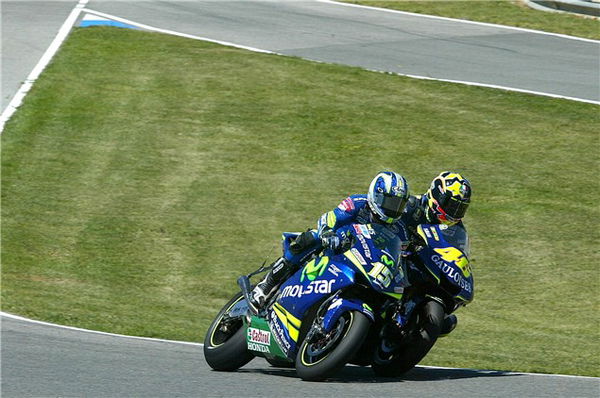
9
9. 2005 JEREZ, SPANISH GRAND PRIX VALENTINO ROSSI AND SETE GIBERNAU
There's no doubt that for two years Sete Gibernau was the only rival to Valentino Rossi, and he beat him often enough to be called a worthy rival. When Rossi switched to Yamaha in 2004, he took Sete seriously enough that relations between the two soured. What turned it happened at Qatar in 2004 - the notorious incident where Rossi was moved to the back of the grid after his team had spun up a scooter tyre on the grid "to give Valentino a reference point" (or to try to work up some grip). Rossi blamed Sete for reporting him, called him "a spy", then proceeded to crash out of the race while Gibernau won. "He will never win another race," prophesied Rossi. He was correct, and the way he made sure of it was almost theatrical.
It was at Jerez in 2005. The two had scrapped to the end, Gibernau was leading on the run to the final hairpin. Until Rossi appeared, barely in control, and diving for the apex. The two touched, Gibernau ricocheted off into the gravel, where he recovered to take a highly disgruntled second. Rossi, unkindly, made fun of him afterwards, suggesting he was rather playing up his supposed shoulder injury. Gibernau's career slowly unwound, from that point onwards.
The 10 best: 8
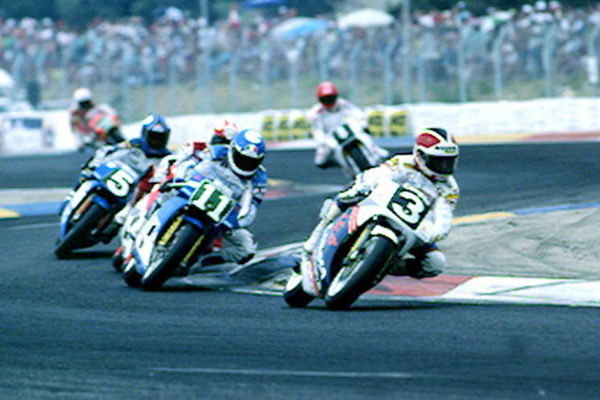
8
8. 1988 BRNO, CZECH 250CC GRAND PRIX JUAN GARRIGA'S AND SITO PONS
Juan Garriga and Sito Pons were both from Catalunya, but poles apart. Pons, sleek and posh, had given up a career as an architect to go racing. Garriga, thin and edgy, had battled his way up from the poor side of town. In 1998 the pair battled for the 250 championship. At Brno, the penultimate round, Garriga raced from 10th to make a ferocious pass on Pons for the win. Garriga's win brought him within six points of Pons' championship lead. Then in Brazil he was taken out on the second lap. Garriga came back from 23rd to fifth, but it wasn't enough. The defeat marked the end of Garriga's prime. After racing he drifted into trading guns and drugs - which led to a stretch in jail.
The 10 best: 7
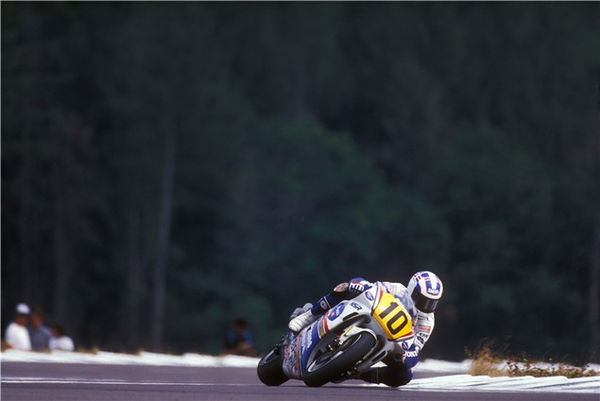
7
7. 1991 JAPANESE GP WAYNE GARDNER'S SWANSONG
Wayne Gardner is another with so many great races it's hard to pick one, ranging from the 1989 Australian GP to his 1992 swansong defeat of Wayne Rainey at Donington Park.
For sheer grit, nothing beats the Japanese GP of 1992. The race was streaming wet. Gardner was one of many who fell victim to the conditions early on, slipping off into the mud at the Esses. The Wild One was never a quitter. He ran back to his filthy bike, ripped off the remains of the screen, and took off after the rest of them, right at the back. Passing four riders in two laps at one point, he was charging to the front. With four laps to go, he was catching fifth-placed Mamola at three seconds a lap. Trying harder still, he slipped off again at the exit of the Esses, right where the guard rail cuts back across the corner exit. He slid under the laughable foam rubber protector and slammed into it, breaking his leg so badly his season was ruined. He later announced his retirement, and then claimed that final win in Great Britain. True grit.
The 10 best: 6

6
6. 2007 SPANISH GP, CASEY STONER AND VALENTINO ROSSI
Tooth-and-nail is alive and well in the 800cc era. The proof came at Catalunya, where almost uncountable overtakes between Rossi and Stoner ended up with the Australian's Ducati ahead by a nose. At the end, his 12kph speed advantage proved decisive. What made it a great race is how hard Rossi tried to overcome it. Not many a rider would have resisted that pressure, no matter how fast his motorcycle. Afterwards, Rossi acknowledged Stoner's feat. "He is riding like a god," he said.
It was the sixth race of the new 800cc era, an age that had started with several surprises. One was that Honda was off the pace. Another was Casey Stoner and his Ducati. The bike was blindingly fast in a straight line, and he was riding consistently fast round the other parts. Last year's frequent crasher has turned into a mature would-be champion.
The 10 best: 5
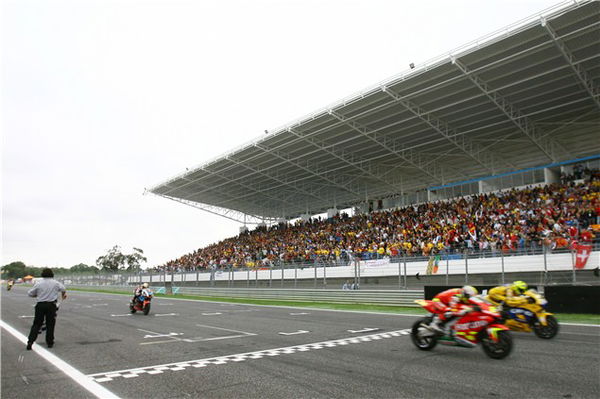
5
5. 2006 PORTUGUESE GP, ELIAS AND ROSSI
Asked back in his 125 days why he had such an aggressive riding style, Toni Elias told us with a toothy laugh, "I like the other people to know I am there." He has a peculiar style, riding the front wheel with the back really loose. Sideways and fast. But it wasn't until the Portuguese GP of 2006 that he'd finally got the tyres he needed to make the most of it on a MotoGP bike. The race was defined early on when championship leader Hayden was skittled by team-mate Pedrosa.
It was a golden chance for Rossi to catch up. But he wasn't alone. Not only did he have former title rival Kenny Roberts for company, he also had Elias. And Elias was letting him know he was there. The battle went to the end, Elias finding ever stranger places to pass Rossi. In the end, his screaming exit from the final corner was too much even for Rossi to cope with. Elias won the race by two thousandths of a second. The five points he cost Rossi were exactly the amount by which he lost the title to Hayden.
The 10 best: 4
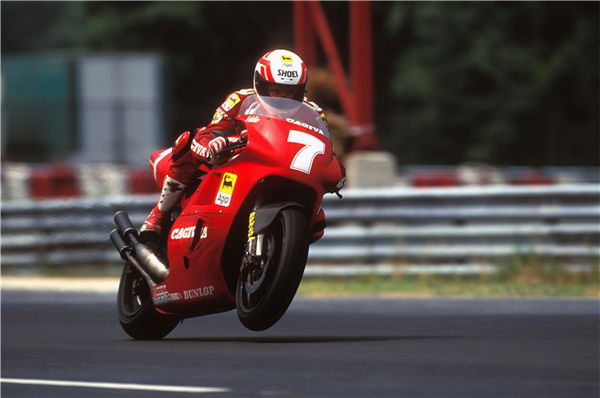
4
4. 1992 HUNGA'RING, HUNGARIAN GP EDDIE LAWSON
'Steady Eddie' recorded the last of his 31 GP wins in the final term of his 10-year career. His last two seasons were on the less than competitive Cagiva V591/592 and despite his abilities he wasn't expected to be winning. Perhaps this led to a freedom to gamble on the wet race at the Hungarian GP in 1992.
Every rider save for Eddie started on full wets. Eddie gambling on the rain stopping and the track drying and chose slicks. Initially he dropped back alarmingly - his gamble looked lost when he'd slipped to over a minute behind the leaders. But at half distance, the rain stopped and the track dried. Eddie got into overdrive. A good 10-seconds a lap advantage saw him storm him through the pack.
When he got to Doug Chandler and Randy Mamola at the front, now on fried wets, they had no defence. Cagiva boss Claudio Castiglioni promptly rewarded Eddie with a Ferrari Testarossa. Remembered for ever by Eddie fans as a great performance, Eddie himself was reticent, "The win meant a lot to me to be the first to win on a Cagiva, but I'm not as proud of that win as I am of others. But hey, winning a GP, no matter how you win, is nice."
The 10 best: 3

3
3. 1991 HOCKENHEIM, GERMAN GRAND PRIX, RAINEY AND SCHWANTZ
Hockenheimring in 1991 was another Rainey-Schwantz classic. Hockenheim was dauntingly fast and this year it was destroying tyres. Schwantz and Rainey shredded several in practice; Dunlop flew special ones in. In the race, series leader Doohan was trying to break away when (irony of ironies) his rear Michelin threw a chunk. It came down to the two old rivals. On the last lap Schwantz regained the lead at the distant Ostkurve, but Rainey drafted past again on the final straight.
Then came Schwantz's epic outbraking move, into the stadium section. The Suzuki was sideways at 180mph - but he was alongside, and had the inside line. Rainey fought back but lost by only 0.016 seconds.
To Schwantz, it was avoidance. "He took me by surprise braking so early, I had to swerve like that to avoid hitting him." To Rainey, it was a typical bonehead move. "It's the way Schwantz used to race. I had to give him room. If it'd been the other way round, he'd have taken me out."
The 10 best: 2
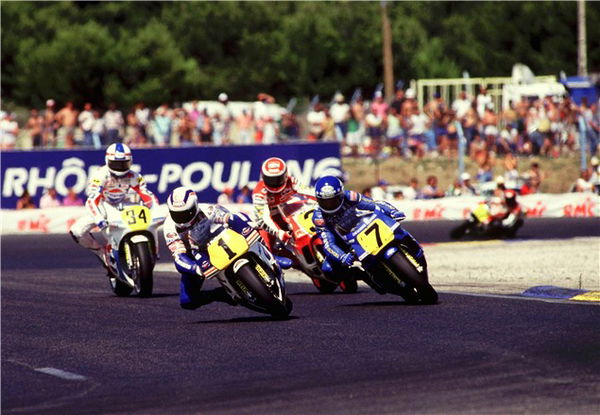
2
2. 1988 PAUL RICARD, FRENCH GRAND PRIX
The old Paul Ricard - using the full Mistral straight - was close to heaven, especially when the weather was as azure-blue as in 1988. The 500cc race, bang in the middle of a golden age, had other aspects of divinity. Wayne Gardner, defending champion, trailed Eddie Lawson by 20 points. But Eddie had dislocated his shoulder a week before. Gardner's luck seemed to be turning.
Problem was the others: Rainey and Schwantz. And Sarron - who had taken his fifth pole in a row. In the race the pace was so hot that Rainey was unable keep up. The first surprise came from injured Eddie (he'd rejected painkillers). Instead of a steady ride, he'd pushed past Rainey, and joined the leading trio.
The sight of four 500s on full noise running into the fast corner at the end of the long straight was unforgettable. With one lap to go, Gardner had the lead. But at the end of the straight, a loosened crankshaft bolt broke into the water pump. He clattered to a stop. Amazingly, he managed to get it going again, on three cylinders, and finish fourth. Up front, Sarron tactfully rode shotgun to Lawson, keeping Schwantz third, less than half a second off the leader. It was one of Eddie's bravest and best races.
The 10 best: 1
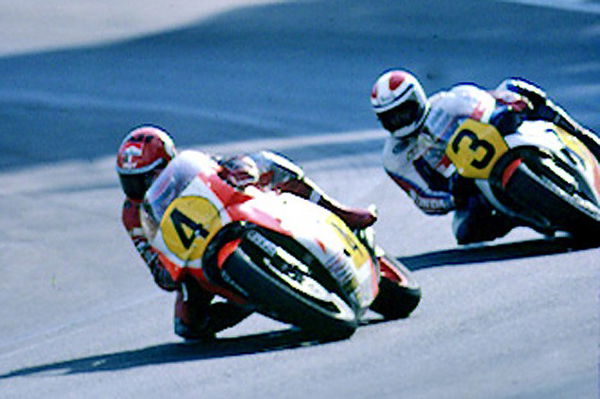
1
1. 1983 ANDERSTORP, SWEDISH GRAND PRIX, KENNY ROBERTS AND FREDDY SPENCER
Kenny Roberts' career yielded at least two iconic moments. One was the battle with Barry Sheene at Silverstone in 1979, which he won. The other race may be more memorable. This time he lost.
Freddie Spencer was his rival, on the nimble three-cylinder Honda. They were neck and neck on points for the '83 championship, with two races left, and had been battling for the lead throughout the Swedish GP.
It came down to the last corner, and Roberts thought he had it covered. "My mistake was I underestimated just how big a risk he would be willing to take," he said later. He braked late, knowing he was on the limit. Yet Spencer came past on the inside. Roberts was right enough about the limit: Freddie didn't make the corner. But he took Roberts out onto the dirt. Spencer recovered first and made it through the last remaining corner to win the race. He went on to win the title by just two points.
